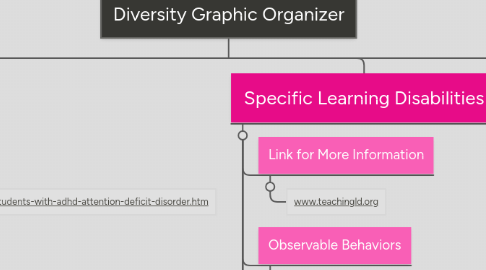
1. Autism
1.1. Link for More Information
1.1.1. www.autismspeaks.com
1.2. Observable Behaviors
1.2.1. Difficulty with verbal and nonverbal communication
1.2.2. Difficulty socializing with others
1.2.3. Follow distinct and clear routines
1.2.4. Overreactive senses
1.3. Impact of Behavior on Literacy
1.3.1. May have difficulty understanding information presented orally
1.3.2. May have difficulty when communicating orally and/or in writing
1.3.3. May have trouble focusing and comprehending information being read
1.4. Assessment Tools
1.4.1. 1. Portfolios of student work created throughout the year
1.4.2. 2. Student created journals recording information learned
1.4.3. 3. Games in class and on computers that test knowledge of the student
1.5. Instructional Strategies
1.5.1. 1. Allow time for individual and independent work in class
1.5.2. 2. Set routines for the student to follow in the classroom
1.5.3. 3. Limit sensory stimuli in the classroom
2. ADD
2.1. Link for More Information
2.1.1. http://www.helpguide.org/articles/add-adhd/teaching-students-with-adhd-attention-deficit-disorder.htm
2.2. Observable Behaviors
2.2.1. Inattention
2.2.2. Hyperactivity
2.2.3. Impulsivity
2.2.4. Difficulty following instructions
2.2.5. Lack of fine motor skills
2.2.6. Frequently off task
2.3. Impact of Behavior on Literacy
2.3.1. Cannot focus when being spoken to
2.3.2. Difficulty writing and communicating through writing
2.3.3. Often go off topic when speaking
2.3.4. Often have trouble focusing on reading
2.4. Assessment Tools
2.4.1. 1. Performance pieces in class
2.4.2. 2. Portfolios of student work created throughout the year
2.4.3. 3. Journaling recording information learned and the students thoughts on the information
2.5. Instructional Strategies
2.5.1. 1. Seat the student close to the teacher
2.5.2. 2. Have the student repeat directions
2.5.3. 3. Use visual aids often
3. Specific Learning Disabilities
3.1. Link for More Information
3.1.1. www.teachingld.org
3.2. Observable Behaviors
3.2.1. Difficulty with fine motor skills
3.2.2. Impulsivity
3.2.3. Hyperactivity
3.2.4. Difficulty with vocabulary and communication
3.2.5. Difficulty paying attention
3.2.6. Poor social skills
3.3. Impact of Behavior on Literacy
3.3.1. Difficulty focusing on reading
3.3.2. Difficulty writing
3.3.3. May have trouble speaking
3.3.4. Difficulty paying attention when being spoken to
3.4. Assessment Tools
3.4.1. 1. Visual representations of knowledge
3.4.2. 2. Group projects
3.4.3. 3. Oral exams
3.5. Instructional Strategies
3.5.1. 1. Model routines and activities
3.5.2. 2. Teach learning strategies
3.5.3. 3. Break tasks into smaller steps
4. Emotional/Behavioral Issues
4.1. Link for More Information
4.1.1. http://www.educationcorner.com/behavioral-disorders-in-the-classroom.html
4.2. Observable Behaviors
4.2.1. Difficulty building relationships
4.2.2. General moods of depression and/or anger
4.2.3. Inappropriate behaviors
4.2.4. Difficulty paying attention
4.2.5. Difficulty sitting still
4.3. Impact of Behavior on Literacy
4.3.1. Difficulty focusing on the speaker
4.3.2. Trouble communicating orally
4.3.3. Reading may be an escape for students
4.3.4. Speaking may cause anxiety for the student
4.4. Assessment Tools
4.4.1. 1. Dialectical journals
4.4.2. 2. Positive behavior checklists
4.4.3. 3. Peer reviews
4.5. Instructional Strategies
4.5.1. 1. Reward positive behaviors
4.5.2. 2. Provide small breaks
4.5.3. 3. Clear and simple rules
5. Giftedness
5.1. Link for More Information
5.1.1. https://www.nagc.org/
5.2. Observable Behaviors
5.2.1. Curious and asks many questions
5.2.2. Retains information easily
5.2.3. Independent thinker
5.2.4. Can easily fall off task
5.2.5. Easily bored
5.2.6. Overly critical of themselves and others
5.3. Impact of Behavior on Literacy
5.3.1. May have trouble listening to the teacher
5.3.2. Strong reading and writing skills
5.3.3. Anxiety about speaking in front of a large group
5.4. Assessment Tools
5.4.1. 1. WebQuests
5.4.2. 2. Class discussions
5.4.3. 3. Open-ended essays
5.5. Instructional Strategies
5.5.1. 1. Frequent independent tasks
5.5.2. 2. Frequent constructive feedback
5.5.3. 3. Heterogenous groupings
